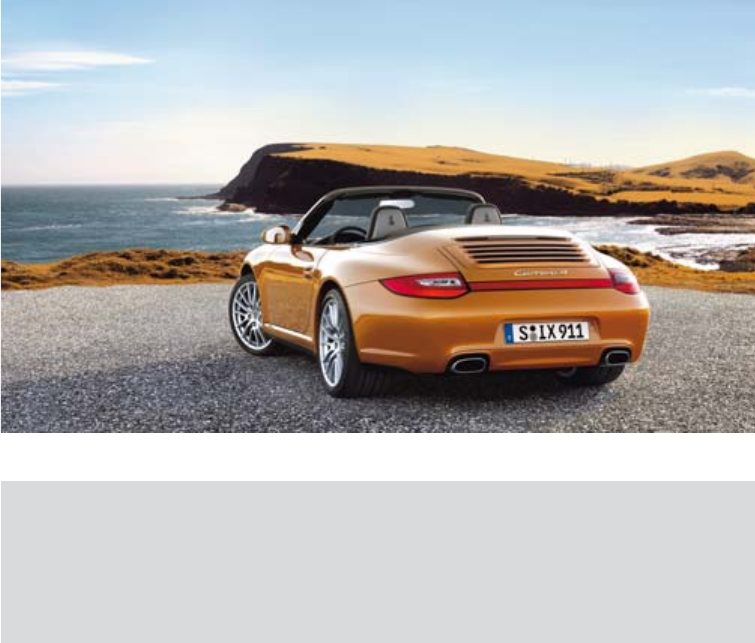
· 132 ·
911 Carrera 4 Cabriolet
In an era of intensifying debate
about CO
2
emissions, every
automotive manufacturer is being
asked the question, ‘What is
your answer to the issue of fuel
consumption?’ Our answer has
long been the same: maximum
efficiency.
Porsche has been reducing the
CO
2
emissions of its vehicles
annually by an average of 1.7%.
As far as engine output is con-
cerned, we are already among
those manufacturers achieving
the lowest CO
2
emissions.This
has been achieved through the
new efficient drive concept (DFI),
lightweight construction, optimum
aerodynamics and low rolling
resistance.
This high level of environmental
responsibility is clearly
demonstrated by our approach
to environmental management
at the Porsche development
In the concept behind the new 911, the source of its appeal
is the achievement of harmony.
Harmony with the environment as well.
· 133 ·
The new 911 | Environment
centre in Weissach. Here, all
technological developments are
carried out with environmental
protection in mind. The goal?
Pure performance – but not at
the expense of the environment.
The result? The new 911. You will
find more information in our
separate brochure, ‘Porsche
and the Environment’, or at
www.porsche.com.
Exhaust emission control.
Both new 911 engines comply
with stringent emission standards,
including EU5 in Europe and LEV II
in the USA. Vehicles manufactured
by Porsche demonstrate that even
high-performance sportscars can
achieve moderate emission values
in their respective category. Indeed,
not only is the new 911 one of
the most exciting cars around, it
is also one of the cleanest.
This is achieved through the
use of a two-stage cascade-type
catalytic converter which compris-
es two monolith substrates on
each of the twin exhaust tracts.
These specially coated substrates
contain ultra-fine honeycomb
channels in which pollutants are
converted as exhaust gas passes
through. The stereo lambda
control circuitry controls and
monitors each cylinder bank
separately, while another lambda
sensor on each cylinder bank
monitors pollutant conversion in
the respective catalytic converter
(p. 49).
Fuel economy and recycling.
At Porsche, a fundamental aspect
of design is intelligent lightweight
construction. For both economical
and ecological reasons.This
forms the basis for low fuel con-
sumption values in conjunction
with outstanding performance.
It is economical thanks to the
high proportion of aluminium
cast alloys, magnesium, plastics
and super high-strength sheet
steel used.This is substantially
more stable and lighter than
conventional steel. In the 911
models approximately 20% of
components are made from
lightweight alloys.
It is also ecological because all
materials used are meticulously
selected. We use only innovative
and environmentally friendly com-
ponents. All lightweight materials
are easily recyclable and each
material is labelled to facilitate
its separation for recycling. The
reduction in the number of plastic
variants helps to ensure more
efficient recycling. Recycled
plastics are used where they
meet our exacting technical
requirements.
In all, the current 911 is
approximately 85% recyclable.
In addition, Porsche primarily uses
environmentally friendly water-
based paints.The 911is absolutely
free of asbestos, CFCs and
components manufactured using
CFCs.This is because, here at
Porsche, environmental protection
does not begin at the end of
a vehicle’s life. It starts at the
planning and development stage.


















